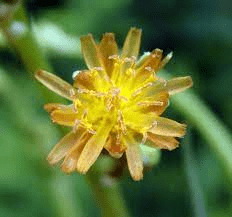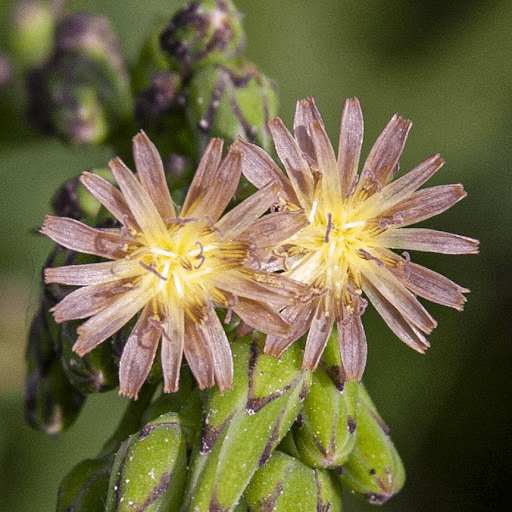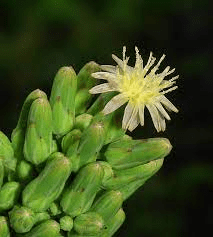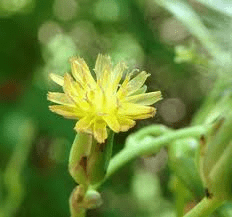TheLettuce Pistil is the female reproductive component of the lettuce flower, essential for seed development and plant reproduction. Each pistil consists of three main parts: the ovary, the style, and the stigma.
In lettuce, which is part of the Asteraceae family, the pistil is found within the individual florets that make up the composite flower head. Here’s a detailed look at each part of the pistil:
1. Ovary: The ovary is the base of the pistil and houses the ovules, which are the female gametes or eggs. In lettuce, the ovary is typically located at the base of the floret, beneath the style and stigma. After pollination, the ovules within the ovary are fertilized, leading to the development of seeds. The ovary’s primary role is to protect these developing ovules and support their maturation.
2. Style: The style is the slender, elongated part of the pistil that connects the ovary to the stigma. It serves as a conduit for pollen to travel from the stigma to the ovary. The length and structure of the style can influence the efficiency of pollen transfer and fertilization. In lettuce, the style is relatively short and ensures that pollen from the stamens of the same or neighboring florets can reach the ovary.
3. Stigma: The stigma is the sticky, receptive tip of the pistil where pollen grains land and adhere. It is the surface where pollen germinates and begins the process of fertilization. The stigma’s sticky surface helps capture and hold pollen, which is crucial for successful fertilization. In lettuce, the stigma is often located at the top of the style and is exposed to the incoming pollen.
During the flowering process, the pistil plays a critical role in reproduction. Pollination occurs when pollen grains from the stamens are transferred to the stigma. This can happen through self-pollination, where pollen from the same flower or flower head fertilizes the ovules, or cross-pollination, where pollen is transferred from another flower or plant. Once pollen lands on the stigma, it germinates and grows down the style to reach the ovary and fertilize the ovules.
After successful fertilization, the ovules develop into seeds within the ovary. The ovary begins to mature and transform into a fruit known as an achene, which contains one seed each. The achenes are eventually dispersed, often with the help of structures like pappi (hair-like appendages) that aid in wind dispersal.
The development and function of the pistil are influenced by various factors, including genetic traits and environmental conditions. For example, temperature, light, and nutrient availability can impact the growth and effectiveness of the pistil. Lettuce, being a cool-season crop, requires careful management of these conditions to ensure optimal flowering and seed production.
In agricultural practices, understanding the role of the pistil can help improve crop management and breeding strategies. For instance, managing environmental conditions to support healthy pistil development can enhance seed production and quality. Additionally, knowledge of pistil function is valuable for breeding programs aimed at developing new lettuce varieties with improved traits, such as higher seed yield or better disease resistance.
The pistil is a crucial component of the lettuce flower, responsible for ovule fertilization and seed development. Its structure, including the ovary, style, and stigma, plays a vital role in the reproductive process, influencing the success of pollination and seed formation. By understanding and managing the factors affecting pistil development, growers can improve lettuce production and contribute to the development of high-quality crops.
The Economic Importance and Uses of Lettuce Pistil

1. Seed Production: The pistil is crucial for lettuce seed production, as it receives pollen from the stamens and facilitates fertilization, leading to seed development.
2. Pollination Support: The pistil plays a vital role in the pollination process by receiving pollen from the stamens, which is essential for successful fertilization and seed production.
3. Herbal Medicine: In traditional herbal medicine, the pistil is sometimes used for its potential mild diuretic and anti-inflammatory properties.
4. Soil Health: When composted, pistils add organic matter to the soil, enriching it with nutrients and improving its structure and fertility.
5. Natural Dyes: The pigments from lettuce pistils can be extracted to create natural dyes for textiles and crafts, offering an eco-friendly alternative to synthetic dyes.
6. Educational Purposes: Lettuce pistils are used in botanical studies to teach about plant reproductive systems, including the role of the female plant parts in fertilization and seed production.
7. Animal Feed: Finely chopped pistils can be included in animal feed, providing additional nutrients for livestock and poultry.
8. Decorative Uses: Dried lettuce pistils can be used in floral arrangements and craft projects, adding texture and visual interest.
9. Eco-Friendly Packaging: Processed pistils can be used in biodegradable packaging materials, reducing reliance on plastic and promoting sustainability.
10. Mulch: Lettuce pistils can be used as mulch in garden beds to help control soil erosion and retain moisture.
11. Biodiversity Support: Growing lettuce plants with healthy pistils supports plant diversity and contributes to local ecosystem stability.
12. Skincare Products: Extracts from lettuce pistils may be used in skincare products for their potential soothing and anti-inflammatory effects on the skin.
13. Natural Pest Control: Lettuce pistils can be used in gardens to help deter certain pests, contributing to sustainable pest management practices.
14. Traditional Crafts: In some cultures, lettuce pistils are used in traditional crafts and ceremonial activities, reflecting their cultural significance.
15. Plant-Based Fiber: The fibers from lettuce pistils can be used to create sustainable products and composites, supporting eco-friendly manufacturing.
16. Herbal Infusions: Lettuce pistils can be used in herbal infusions to offer mild health benefits and a unique flavor.
17. Homemade Teas: Dried pistils can be brewed into herbal teas, providing a calming beverage with potential health benefits.
18. Educational Crafts: Lettuce pistils are used in educational craft projects to illustrate plant anatomy and reproductive functions.
Read Also: The Appearance and Features of Cats
The Products and By-products That Can Be Derived From Lettuce Pistils

1. Lettuce Seeds: Pistils are essential for the production of lettuce seeds, which are crucial for growing new lettuce plants.
2. Natural Dyes: Pigments from lettuce pistils can be used to create natural dyes for textiles and crafts.
3. Herbal Teas: Dried lettuce pistils can be brewed into herbal teas, offering a unique flavor and potential health benefits.
4. Compost: Lettuce pistils can be composted to add organic matter and nutrients to the soil.
5. Animal Feed: Finely chopped lettuce pistils can be added to animal feed to provide additional nutrition.
6. Biodegradable Packaging: Processed lettuce pistils can be used in the production of biodegradable packaging materials.
7. Skincare Products: Extracts from lettuce pistils are used in skincare formulations for their potential soothing and anti-inflammatory properties.
8. Decorative Items: Dried lettuce pistils can be used in floral arrangements and crafts, adding visual appeal and texture.
9. Mulch: Lettuce pistils can be used as mulch to help control soil erosion and retain moisture in garden beds.
10. Educational Materials: Lettuce pistils are used in educational settings to teach about plant reproductive systems and anatomy.
11. Herbal Infusions: Infused with water, lettuce pistils create herbal infusions with mild health benefits.
12. Plant-Based Composites: Fibers from lettuce pistils can be used to create plant-based materials and composites for sustainable product development.
13. Traditional Crafts: Lettuce pistils are used in traditional crafts and ceremonies, reflecting cultural practices.
14. Natural Pest Repellent: Lettuce pistils can help repel pests when used in gardens, contributing to integrated pest management.
15. Soil Amendment: Used as a soil amendment or compost ingredient, lettuce pistils improve soil health and fertility.
16. Educational Crafts: Lettuce pistils are used in crafts and activities to demonstrate plant anatomy and reproductive systems.
17. Eco-Friendly Gardening: Lettuce pistils support sustainable gardening practices by enhancing soil health and contributing to pest management.
Read Also: Importance and Types of Pets
Frequently Asked Questions (FAQ’s) About Lettuce Pistils

1. What are lettuce pistils?
Lettuce pistils are the female reproductive parts of the lettuce flower. They receive pollen from the stamens and facilitate fertilization, leading to seed production.
2. How do lettuce pistils contribute to seed production?
Lettuce pistils receive pollen from the stamens, which fertilizes the ovules. This fertilization process results in the formation of lettuce seeds, which are essential for growing new plants.
3. Can lettuce pistils be used in herbal medicine?
Yes, in traditional herbal medicine, lettuce pistils are sometimes used for their potential mild diuretic and anti-inflammatory properties.
4. How can lettuce pistils be used in natural dyes?
Pigments from lettuce pistils can be extracted and used to create natural dyes for textiles and crafts, offering a sustainable alternative to synthetic dyes.
5. Are lettuce pistils beneficial for soil health?
Yes, composting lettuce pistils adds organic matter to the soil, improving its structure, fertility, and moisture retention.
6. Can lettuce pistils be used in animal feed?
Yes, finely chopped lettuce pistils can be included in animal feed to provide additional nutrients for livestock and poultry.
7. How are lettuce pistils used in decorative projects?
Dried lettuce pistils can be used in floral arrangements and crafts, where they add texture and visual appeal.
8. What are the educational uses of lettuce pistils?
Lettuce pistils are used in botanical studies to teach about plant reproductive systems and the role of female plant parts in seed production.
9. Can lettuce pistils be used in skincare products?
Yes, extracts from lettuce pistils may be used in skincare products for their potential soothing and anti-inflammatory effects.
10. How can lettuce pistils help in pest control?
Lettuce pistils can be used in integrated pest management strategies to help deter pests in gardens and agricultural settings, supporting sustainable gardening practices.
Read Also: How to Grow Tomatoes in Containers






